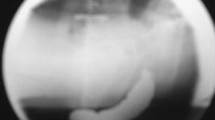Abstract
Background: The purpose of this study was to evaluate the clinical outcome of laparoscopic rectopexy and its effect on anorectal function investigations.
Methods: Twelve patients with complete rectal prolapse without constipation underwent laparoscopic rectopexy. Pre- and postoperative evaluation included scoring of incontinence, anorectal manometry, and anal endosonography.
Results: No recurrences of rectal prolapse were seen (median follow-up 19 months). Continence improved in eight of nine preoperatively incontinent patients. Two patients had mild constipation after surgery. Median maximum basal pressure measured by anorectal manometry increased from 20 to 25 mmHg (p=0.005) and the rectoanal inhibitory reflex improved in seven patients (p=0.03). Rectal sensitivity did not change significantly. Endosonography showed asymmetry and thickening of the internal anal sphincter and submucosa preoperatively. After surgery the maximum internal anal sphincter thickness decreased from 3.0 mm to 2.6 mm (p=0.02).
Conclusions: Laparoscopic rectopexy improved continence in our patients. Anorectal function tests show a partial recovery of the internal anal sphincter. Laparoscopic rectopexy combines the low morbidity of minimal invasive surgery with the good outcome of abdominal rectopexy.
Similar content being viewed by others
References
Bartram CI (1992) Anal endosonography. Ann Gastroenterol Hepatol 28: 185–189
Berman IR (1992) Sutureless laparoscopic rectopexy for procidentia: technique and implications. Dis Colon Rectum 35: 689–693
Blaker R, Senagore AJ, Luchtefeld MA (1995) Laparoscopic assisted vs. open resection. Rectopexy offers excellent results. Dis Colon Rectum 38: 199–201
Broden G, Dolk A, Holmstrom B (1988) Recovery of the internal anal sphincter following rectopexy: a possible explanation for continence improvement. Int J Colorectal Dis 3: 23–28
Burnett S, Bartram CI (1991) Endosonographic variations in the normal internal anal sphincter. Int J Colorectal Dis 6: 2–4
Cuesta MA, Borgstein PJ, De Jong D, Meijer S (1993) Laparoscopic rectopexy. Surg Laparosc Endosc 3: 456–458
Cuesta MA, Meijer S, Derksen EJ, Boutkan H, Meuwissen S (1992) Anal sphincter imaging in fecal incontinence using endosonography. Dis Colon Rectum 35: 59–63
Cuschieri A, Shimi SM, Vander VG, Banting S, Wood RAB (1994) Laparoscopic prosthesis fixation rectopexy for complete rectal prolapse. Br J Surg 81: 138–139
Delemarre JBVM, Gooszen HG, Kruyt RH, Soebhag R, Geesteranus AM (1991) The effect of posterior rectopexy on fecal continence. A prospective study. Dis Colon Rectum 34: 311–316
Duthie GS, Bartolo DCC (1992) Abdominal rectopexy for rectal prolapse: a comparison of techniques. Br J Surg 79: 107–113
Farouk R, Duthie GS, Bartolo DCC, MacGregor AB (1992) Restoration of continence following rectopexy for rectal prolapse and recovery of the internal anal sphincter electromyogram. Br J Surg 79: 439–440
Farouk R, Duthie GS, MacGregor SAB, Bartolo DCC (1994) Rectoanal inhibition and incontinence in patients with rectal prolapse. Br J Surg 81: 743–746
Felt-Bersma RJF, Klinkenberg-Knol EC, Meuwissen SGM (1990) Anorectal function investigations in incontinent and continent patients. Differences and discriminatory value. Dis Colon Rectum 33: 479–486
Felt-Bersma RJF, Van Baren R, Koorevaar M, Strijers RL, Cuesta MA (1995) Unsuspected sphincter defects shown by anal endosonography after anorectal surgery: a prospective study. Dis Colon Rectum 38: 249–253
Graf W, Ejerblad S, Krog M, Pahlman L, Gerdin B (1992) Delorme's operation for rectal prolapse in elderly or unfit patients. Eur J Surg 158: 555–557
Hoitsma HFW, Meijer S, Klinkenberg-Knol EC, Den Otter G (1984) The treatment of complete rectal prolapse by transabdominal posterior rectopexy. Neth J Surg 36: 73–76
Johansen OB, Wexner SD, Daniel N, Nogueras JJ, Jagelman DG (1993) Perineal rectosigmoidectomy in the elderly. Dis Colon Rectum 36: 767–772
Keighley MRB, Fielding JWL, Alexander-Williams J (1983) Results of Marlex mesh abdominal rectopexy for rectal prolapse in 100 consecutive patients. Br J Surg 70: 229–232
Lechaux JP, Lechaux D, Perez M (1995) Results of Delorme's procedure for rectal prolapse. Advantage of a modified technique. Dis Colon Rectum 38: 301–307
Madden MV, Kamm MA, Nicholls RJ, Santhanam AN, Cabot R, Speakman CTM (1992) Abdominal rectopexy for complete prolapse: prospective study evaluating changes in symptoms and anorectal function. Dis Colon Rectum 35: 48–55
McCue JL, thomson JPS (1991) Clinical and functional results of abdominal rectopexy for complete rectal prolapse. Br J Surg 78: 921–923
McKee RF, Lauder JC, Poon FW, Aitchison MA, Finlay IG (1992) A prospective randomized study of abdominal rectopexy with and without sigmoidectomy in rectal prolapse. Surg Gynecol Obstet 174: 145–148
Neilsen MB, Hauge C, Rasmussen OO, Sorensen M, Pedersen JF, Christiansen J (1992) Anal sphincter size measured by endosonography in healthy volunteers. Effect of age, sex and parity. Acta Radiol 33: 453–456
Parks AG (1975) Anorectal incontinence. Proc R Soc Med 68: 681–690
Ramanujam PS, Venkatesh KS, Fietz MJ (1994) Perineal excision of rectal procidentia in elderly high risk patients. A ten-year experience. Dis Colon Rectum 37: 1027–1030
Scaglia M, Fasth S, Hallgren T, Nordgren S, Oresland T, Hulten L (1994) Abdominal rectopexy for rectal prolapse: influence of surgical technique on functional outcome. Dis Colon Rectum 37: 185–189
Speakman CT, Madden MV, Nicholls RJ, Kamm MA (1991) Lateral ligament division during rectopexy causes constipation but prevents recurrence: results of a prospective randomized study. Br J Surg 78: 1431–1433
Tjandra JJ, Fazio VW, Church JM, Milson JW, Oakley JR, Lavery IC (1993) Ripstein procedure is an effective treatment for rectal prolapse without constipation. Dis Colon Rectum 36: 501–507
Williams JG, Wong WD, Jensen L, Rothenberger DA, Goldberg SM (1991) Incontinence and rectal prolapse: a prospective manometric study. Dis Colon Rectum 34: 209–216
Author information
Authors and Affiliations
Rights and permissions
About this article
Cite this article
Poen, A.C., de Brauw, M., Felt-Bersma, R.J.F. et al. Laparoscopic rectopexy for complete rectal prolapse. Surg Endosc 10, 904–908 (1996). https://doi.org/10.1007/BF00188480
Issue Date:
DOI: https://doi.org/10.1007/BF00188480




